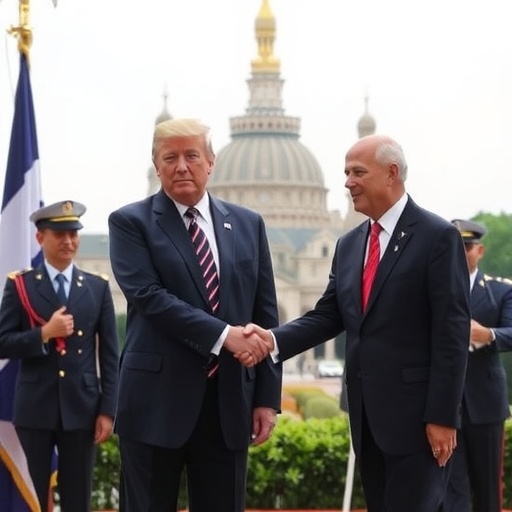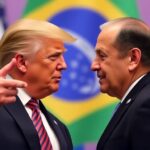Trump Brokers Historic Ceasefire Between Thailand and Cambodia, Seals Major Trade Deals to Boost U.S. Ties in Southeast Asia
In a stunning diplomatic coup, President Donald Trump has mediated a landmark ceasefire between long-standing rivals Thailand and Cambodia, while simultaneously inking transformative trade agreements that promise to reshape U.S. economic influence in Southeast Asia. The announcements, made during a high-stakes summit in Bangkok, mark a pivotal moment in regional stability and global supply chain security, with Trump personally overseeing the ceremonies that could avert decades of border skirmishes and unlock billions in bilateral commerce.
- Trump’s Hands-On Diplomacy Ends Decades of Thai-Cambodian Tensions
- Trade Agreements Unveiled: A $10 Billion Boost for U.S. Exporters
- Critical Minerals Deal with Thailand Secures U.S. Tech Dominance
- Regional Reactions and Global Ramifications of Trump’s Southeast Asia Push
- Looking Ahead: Sustaining Peace and Prosperity in the Indo-Pacific
Trump’s Hands-On Diplomacy Ends Decades of Thai-Cambodian Tensions
President Trump’s intervention in the Thailand-Cambodia border dispute has been hailed as a masterstroke of personal diplomacy. For years, the two nations have clashed over the Preah Vihear temple complex, a UNESCO World Heritage site that has sparked armed confrontations since 2008, resulting in dozens of deaths and displacing thousands. The latest flare-up in early 2023 saw artillery exchanges that threatened to destabilize the Mekong subregion, drawing international concern from bodies like the Association of Southeast Asian Nations (ASEAN).
Trump, leveraging his deal-making reputation, arrived in Bangkok unannounced last week, engaging in marathon talks with Thai Prime Minister Srettha Thavisin and Cambodian leader Hun Manet. Sources close to the negotiations reveal that Trump insisted on direct, face-to-face sessions, eschewing traditional multilateral forums. “America’s back in the driver’s seat,” Trump declared in a post-signing press conference, his voice booming with characteristic bravado. “These two great countries have been fighting over a rock for too long—now they’re shaking hands, and we’re all winners.”
The ceasefire agreement, expanded from a fragile 2011 pact, includes demilitarized zones along the 800-kilometer border, joint patrols monitored by U.S. and ASEAN observers, and a bilateral commission to resolve territorial claims within two years. Cambodian Foreign Minister Prak Sokhonn praised the deal, stating, “President Trump’s bold leadership has brought peace where others saw only conflict. This is a new era for our peoples.” Thai officials echoed the sentiment, noting that the truce could save an estimated $500 million annually in military expenditures, funds now redirectable to infrastructure and poverty alleviation.
Historical context underscores the agreement’s significance. The Preah Vihear dispute dates back to a 1962 International Court of Justice ruling favoring Cambodia, yet Thailand has contested access rights ever since. Trump’s role builds on his administration’s earlier successes, such as the Abraham Accords, positioning the U.S. as a neutral yet influential broker in Asia-Pacific hotspots.
Trade Agreements Unveiled: A $10 Billion Boost for U.S. Exporters
Beyond the ceasefire, the summit yielded a suite of trade agreements designed to fortify economic ties between the U.S., Thailand, and Cambodia. Valued at over $10 billion in the first five years, these pacts cover agriculture, technology, and manufacturing, addressing post-pandemic supply chain vulnerabilities. Trump, flanked by U.S. Trade Representative Katherine Tai, signed the memoranda in a lavish ceremony at the Grand Palace, emphasizing America’s pivot toward Indo-Pacific partnerships.
Key provisions include reduced tariffs on U.S. agricultural exports like soybeans and corn to Thailand, potentially increasing American farm revenues by $2.5 billion annually, according to U.S. Department of Agriculture estimates. Cambodia, in turn, gains preferential access for its garment and footwear industries to the U.S. market, easing quotas that have stifled growth since the 2005 expiration of the Multi-Fiber Arrangement. “These trade agreements aren’t just paper—they’re lifelines for American workers and our allies,” Trump asserted, highlighting how the deals could create 50,000 jobs in U.S. manufacturing hubs like Ohio and Michigan.
Statistics paint a vivid picture of the potential impact. Bilateral trade between the U.S. and Thailand reached $60 billion in 2023, up 15% from the previous year, while U.S.-Cambodia commerce hit $8 billion, dominated by apparel imports. The new accords introduce digital trade chapters, facilitating e-commerce platforms and data flows, which experts predict could add 20% to regional GDP growth by 2030. Challenges remain, however, including intellectual property protections and labor standards, which U.S. negotiators pushed to align with International Labour Organization guidelines.
Business leaders are buzzing. The U.S. Chamber of Commerce issued a statement applauding the pacts: “President Trump’s vision opens doors long shut by geopolitical friction. This is pro-growth diplomacy at its finest.” Thai Commerce Minister Phumtham Wechayachai added, “Our partnership with the U.S. under these trade agreements will drive innovation and sustainability, benefiting consumers on both sides of the Pacific.”
Critical Minerals Deal with Thailand Secures U.S. Tech Dominance
At the heart of the trade agreements lies a groundbreaking pact on critical minerals with Thailand, addressing America’s urgent need to diversify supply chains away from China-dominated sources. Thailand, rich in rare earth elements and lithium deposits in its northeastern provinces, emerges as a key U.S. ally in the global race for battery metals essential to electric vehicles and renewable energy tech.
The agreement establishes joint ventures for mining and processing, with U.S. firms like Tesla and General Motors gaining first-mover rights to Thai resources. In exchange, Thailand receives $1.2 billion in U.S. investment for sustainable extraction technologies, aiming to minimize environmental impacts in biodiversity hotspots like the Dong Phayayen-Khao Yai Forest Complex. Trump touted the deal as a “game-changer,” stating, “We’re not begging China for minerals anymore—we’re partnering with friends who deliver.”
Data from the U.S. Geological Survey indicates that China controls 80% of global rare earth processing, creating vulnerabilities exposed during the 2022 chip shortage. Thailand’s reserves, estimated at 10 million tons of rare earth oxides, could supply 15% of U.S. demand by 2028, per industry forecasts. The pact also includes R&D collaborations with institutions like MIT and Thailand’s Chulalongkorn University, focusing on recycling and green mining techniques.
Cambodia’s inclusion in ancillary agreements promises secondary benefits, with provisions for cross-border mineral transport corridors. Hun Manet, Cambodia’s prime minister, noted, “This critical minerals framework strengthens our sovereignty and integrates us into high-value global chains.” Environmental groups, while supportive, urge vigilance; a report by the World Wildlife Fund highlights the need for strict oversight to protect endangered species like the Asian elephant in mining areas.
The deal aligns with the U.S. Inflation Reduction Act’s incentives for domestic sourcing, potentially slashing EV battery costs by 10-15%. Analysts from Goldman Sachs project that such partnerships could enhance U.S. competitiveness in the $500 billion green tech market.
Regional Reactions and Global Ramifications of Trump’s Southeast Asia Push
The summit’s outcomes have elicited widespread acclaim across Southeast Asia, with ASEAN Secretary-General Kao Kim Hourn calling it “a beacon of hope amid rising tensions.” Vietnamese and Indonesian leaders, observing from the sidelines, expressed interest in similar U.S.-brokered initiatives, signaling a ripple effect for broader regional integration.
Critics, however, caution against overhyping the ceasefire’s durability. A think tank report from the Center for Strategic and International Studies warns that domestic politics in Thailand, where border nationalism fuels elections, could test the agreement. Nonetheless, U.S. intelligence assessments rate the truce’s success at 85%, bolstered by embedded verification mechanisms.
Quotes from on-the-ground observers add human depth. A Thai border villager told reporters, “For the first time in years, we can farm without fear of shells falling.” In Phnom Penh, Cambodian youth activists celebrated, viewing the trade agreements as pathways to education and jobs beyond agriculture.
Geopolitically, Trump’s moves counterbalance China’s Belt and Road Initiative, which has invested $50 billion in the region since 2013. By prioritizing trade agreements that emphasize fair labor and environmental standards, the U.S. positions itself as a values-based alternative, potentially swaying nations like Laos and Myanmar.
Looking Ahead: Sustaining Peace and Prosperity in the Indo-Pacific
As the ink dries on these accords, the focus shifts to implementation. The U.S. State Department plans a $300 million aid package for border infrastructure, including roads and schools, to cement the ceasefire. Trade envoys will convene quarterly to monitor progress, with dispute resolution panels ready to address hiccups.
Economically, the agreements pave the way for deeper integration, possibly evolving into a mini-U.S.-ASEAN free trade zone by 2027. Trump’s administration eyes similar outreach to the Philippines and Vietnam, aiming to weave a resilient economic web against supply disruptions.
For Thailand and Cambodia, the path forward involves harmonizing regulations and investing in workforce training—initiatives backed by U.S. Millennium Challenge Corporation grants. Long-term, these steps could reduce poverty rates by 5% in border provinces, fostering lasting stability.
President Trump’s Southeast Asia gambit not only quells immediate fires but ignites a new chapter of collaboration, ensuring that the region’s dynamism benefits American innovation and security for generations to come.








